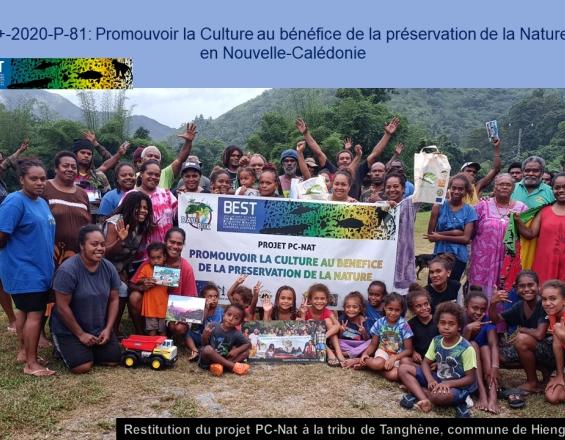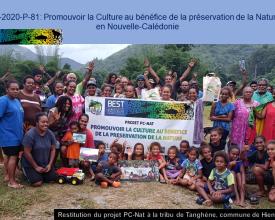
Promoting culture to preserve nature

The Dayu Biik association's Board of Directors and technical team realized that the association's culture and traditional knowledge were not being promoted, so they took the initiative of creating a forum for dialogue. The Dayu Biik team, together with the team from the Hienghène cultural center, asked the two major chieftaincies to bring together the traditional chiefs so that the team could present this concerted effort. Following this meeting, we drew up a schedule of consultation meetings in the various tribes. The meetings took place in the presence of the Dayu Biik team, the cultural center team and the Bwarhat grand chief. Thanks to BEST2.0+ funding, the association was able to create various awareness-raising materials on the role of culture in protecting nature.
Context
Challenges addressed
Environmental challenges include enriching biodiversity and combating soil degradation caused by the absence of forest cover.
The social challenges are to raise awareness of environmental issues, in particular fire and soil erosion, and to pass on traditional know-how to younger generations.
The project represents an economic opportunity for the local population. Local nurserymen supply the seedlings needed for the reforestation operation.
Location
Process
Summary of the process
The constituent elements of the PANORAMA solution really do interact with one another to highlight the inseparability of Culture and Nature:
- the development of a booklet showing the cultural aspect is integrated into environmental management measures;
- the creation of a range of communication tools to facilitate nature conservation and cultural promotion activities;
- awareness-raising activities have been organized and run efficiently thanks to the tools created;
- reforestation with endemic and indigenous seedlings in the watershed of the water catchment where the sacred site is located demonstrates that the cultural values of a site contribute to the preservation of nature.
Building Blocks
Creation of a booklet on culture and nature
The purpose of the booklet is to create a practical tool or guide for clan chiefs and customary people from all tribes in the Hienghène commune, on culture-based environmental management measures. The contents of this booklet include the methodology for organizing and conducting consultation meetings, and summaries of each consultation meeting. It also includes a table summarizing the summaries of all the remote tribes of the wilderness reserve. The same applies to the 5 tribes close to the reserve. As people have expressed themselves freely in their own languages, the Académie des Langues Kanak, a stakeholder in the project, verifies the texts in local languages. The final phase of the booklet consists of computer graphics and printing, carried out by the project's off-site service providers.
Enabling factors
The willingness and energy of the project team, together with the work of local language translators, contributed to the success of the booklet, a tool or practical guide for local communities on integrating the cultural dimension into environmental management measures.
Lesson learned
The project team struggled to design the booklet due to a lack of expertise. A lot of time had to be spent working together to get it right. Training in book design would be necessary beforehand. Translation took time, as the Académie des Langues Kanak did not have enough translators to meet our translation and proofreading needs in time.
Organizing awareness campaigns
The aim of organizing awareness-raising activities on biodiversity and water resources is to inform and raise public awareness of environmental issues, in particular local biodiversity and water resources. Three results have been defined:
- the organization of World Water Day, to raise public awareness, particularly among schoolchildren, of the issues and traditional know-how relating to water resources;
- the organization of a day of exchange and transmission on the services rendered by nature, in particular water resources;
- restitution in the tribes of the actions carried out during the implementation of the project, followed by the distribution of booklets and a photo taken during the consultation meeting.
Enabling factors
The partners we approached were all on hand to present their water-related activities on World Water Day. They got involved. The same goes for the schoolchildren who were invited - they responded positively to take part in the day.
As for the feedback meetings at the end of the project, the local communities turned out in large numbers, reflecting their enthusiasm for protecting their environment and water resources.
Lesson learned
The choice of holding the feedback meetings towards the end of the project is not ideal, as there is not enough time to organize all the meetings in the event of a major tribal impediment. In fact, the project team encountered such an incidence when there were three bereaved tribes. As a result, the team was obliged to extend activities by a week after the official end of project implementation.
Creation of communication tools
The project is based on awareness-raising activities. In fact, the creation of communication media is an excellent way of supporting awareness-raising activities:
- the environmental hut built on the animation site helped the activities proposed to the school public on the transmission of knowledge on the heritage species indicated on panels. Local languages were highlighted, in close collaboration with the Agence des Langues Kanak, with translation into French.
- photos were taken and given to the local communities taking part in the consultation meetings. Panels on heritage species and the cultural values of drinking water resources were produced.
- a documentary film to promote the project was produced by a member of the project team following video training organized by a professional service provider at the start of the project;
- to raise the project's profile, ecological t-shirts, caps and bags have been produced, bearing the logos of our funding partners.
Enabling factors
The project team's genuine willingness to take charge of the various activities involved in creating the communications media contributed to their completion: contacting service providers, designing the panels, organizing the logistics for the smooth running of the video training and documentary film production.
Lesson learned
Poor time management for activities leads to delays in project completion. A margin of at least a fortnight should be allowed to ensure that all planned activities are completed before the end of project implementation.
Reforestation operation
The reforestation of degraded watersheds is seen as a means of raising awareness among local communities. It also helps to conserve local biodiversity, as reclaiming the forest is one way of combating soil erosion.
Enabling factors
It was the enthusiasm of the local population of the tribe where the planting site is located, schoolchildren, and environmental and cultural associations that made the reforestation operation a success. Local nurserymen who produce endemic and native seedlings ensured the supply of the necessary seedlings in terms of number and quality.
Lesson learned
If you forget to mulch young plants, this could have an adverse effect on them. In other words, the mortality rate of young plants is higher than that of mulched plants.
Impacts
The project's impact on the environment consists of restoring biodiversity by reforesting with endemic and indigenous plant species, and combating soil erosion in the drinking water catchment area.
Secondly, the project's social impact involves raising awareness of environmental issues among the local population, and passing on traditional know-how through the production of a booklet on the importance of culture in preserving nature.
Finally, the economic impact is local, as the seedlings for reforestation come from local nurseries. This enables certain members of the local population to have an income-generating activity.
Beneficiaries
The direct beneficiaries are all the clan chiefs and traditional leaders in the commune of Hienghène.
Indirect beneficiaries are the country's other communes, as the project can be replicated nationwide.
Sustainable Development Goals
Story

During the implementation of our PC-Nat project, the project team met and mingled with many motivated, determined and highly involved people in the commune of Hienghène. He's an exceptional person, a rallying force, an emblematic figure and, above all, someone with a clear vision of the importance of protecting the environment and a great respect for his own culture. He is Vice-President of the Hoot Ma Whaaap customary area, geographically located in the northern part of New Caledonia, President of the Doo Huny association, manager of the Goa Ma Bwarhat Cultural Center in Hienghène, and chief of his clan in the Tanghène tribe. His name is Victorin Mampasse, in the Djeo language. He is a true leader, fully playing his role as clan chief. He succeeded in bringing together young people from two neighboring tribes to form an association before the end of our project. At the feedback meeting, he was always in a good mood, smiling and enthusiastic, and said he found our project very inspiring and was counting on us to support them in the near future!

